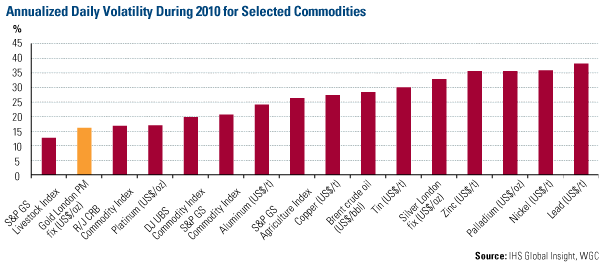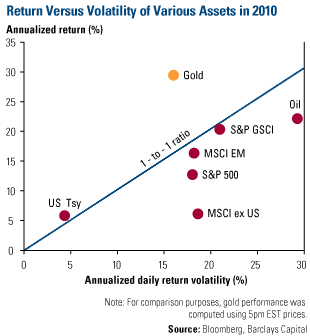Gold is a volatile asset class. This is why we tell investors to put no more than 5-10 percent of their portfolio in gold, and split that among the bullion itself and those companies tasked with exploring for and producing gold.
However, when compared to other commodities last year, gold looks relatively calm. This chart from the World Gold Council (WGC) shows the annualized daily volatility for selected commodities such as copper, silver, tin and others.

As you can see, gold was the second-least volatile of the group behind livestock. In fact, the annualized daily volatility for metals like zinc, palladium, lead and nickel were more than twice that of gold.
Gold’s annualized volatility came in at 16.1 percent in 2010, down from 21.4 percent in 2009. Last year’s volatility is on par with that of the past 20 years, where gold’s annualized volatility has averaged 15.8 percent, according to the World Gold Council (WGC). The annualized figures for the S&P Goldman Sachs Commodity Index and crude oil were 20.84 percent and 28.4 percent, respectively.
The latest Gold Investment Digest from the WGC highlights the risk-adjusted performance gold was able to turn in during 2010. This next chart shows gold’s 29.5 percent return was both higher and less volatile than the likes of the MSCI Emerging Markets Index and the S&P 500 Index.
 Surprisingly, of the asset classes shown, only U.S. Treasuries were less volatile last year but only managed roughly one-sixth the return of gold.
Surprisingly, of the asset classes shown, only U.S. Treasuries were less volatile last year but only managed roughly one-sixth the return of gold.
Speaking of volatility, since peaking at a price of $1,420 on the London Exchange on December 7, 2010 gold prices slid 3.7 percent through January 14, 2011. The gold naysayers, as I affectionately call them, will likely say this is a sign gold’s bull run is over. However, the WGC points out that this is considerably less than one standard deviation move for gold. Over the past 10 years, gold’s average volatility in a given month is 4.9 percent, according to the WGC.
When investing in gold, it’s important to remember gold’s volatility. Instances like the current gold reversion provide opportunity to get more bang for your buck, which is what many gold investors are looking for in the first place.
- Bulenox: Get 45% to 91% OFF ... Use Discount Code: UNO
- Risk Our Money Not Yours | Get 50% to 90% OFF ... Use Discount Code: MMBVBKSM
Disclaimer: This page contains affiliate links. If you choose to make a purchase after clicking a link, we may receive a commission at no additional cost to you. Thank you for your support!



Leave a Reply